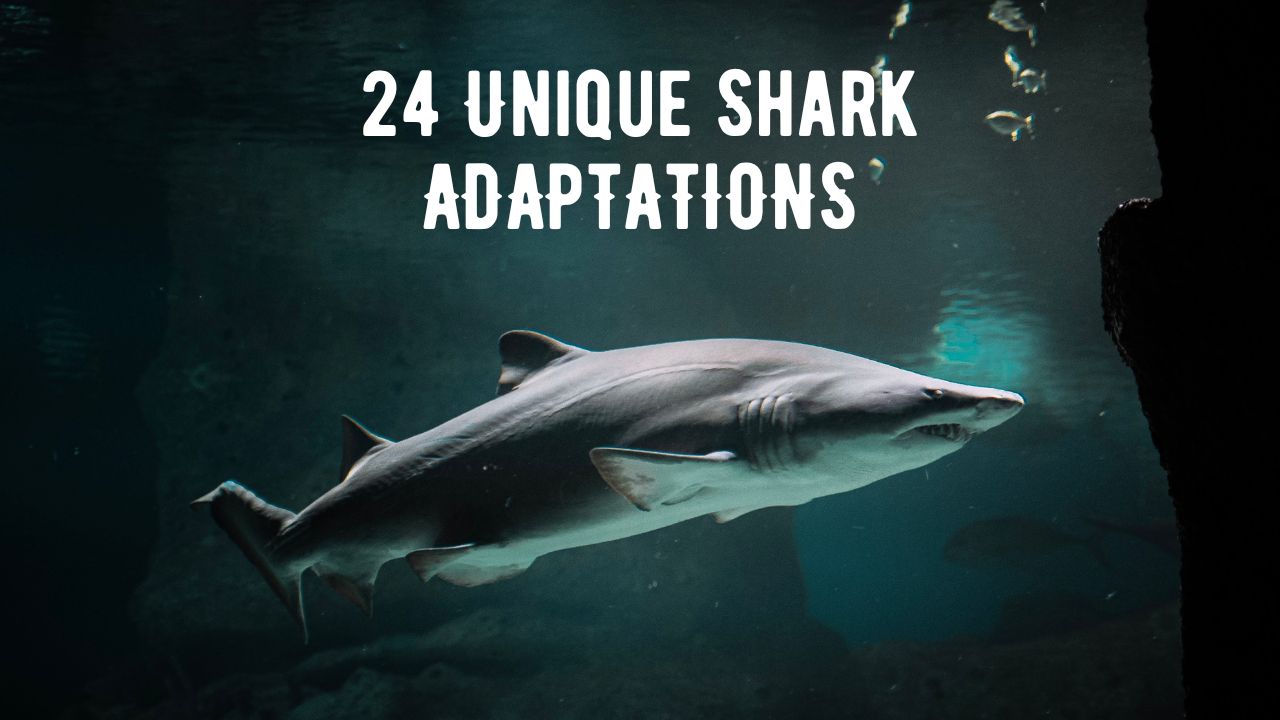
Sharks, as ancient and formidable predators, have evolved a myriad of unique adaptations that distinguish them as masters of the marine realm. From their streamlined bodies to specialized sensory organs, these adaptations contribute to their efficiency as apex predators. In this exploration, we delve into some of the remarkable and distinctive adaptations that define the evolutionary success of sharks.
I. Streamlined Body Shape
Sharks boast a streamlined and hydrodynamic body shape, a key adaptation that enhances their swimming efficiency. This design minimizes drag as they move through the water, allowing them to navigate swiftly and with precision. The fusiform body shape, characterized by a tapered head and torpedo-like body, is a common feature across many shark species.
II. Unique Skin Composition
The skin of sharks is unlike that of any other fish. Instead of scales, sharks have dermal denticles, tiny tooth-like structures that cover their skin. These denticles not only reduce drag but also provide protection against parasites and injuries. The abrasive texture of shark skin has inspired innovations in swimwear and materials designed to improve the efficiency of underwater vehicles.
III. Sensory Organs: Ampullae of Lorenzini
Sharks possess a highly developed sensory system, and one of their most intriguing adaptations is the presence of the ampullae of Lorenzini. These small, jelly-filled pores located on the shark’s head can detect the electric fields generated by the muscle contractions and movements of prey. This electroreception ability is particularly useful in locating hidden prey, even in dark or murky waters.
IV. Replaceable Teeth
Unlike most vertebrates, sharks have a unique dental arrangement – rows of replaceable teeth. Shark teeth are not embedded in the jaw but rather attached to the skin-covered surface. When a tooth is lost during hunting or feeding, a new one from the reserve row moves forward to replace it. This continuous cycle of tooth replacement ensures that sharks always have functional and sharp teeth for capturing prey.
V. Buoyancy Control: Large Liver
Sharks maintain buoyancy through a large liver that contains a high concentration of oil, specifically squalene. This oil is less dense than water, providing buoyancy to counteract the shark’s weight. The ability to control buoyancy is crucial for sharks that may need to remain suspended in water or make rapid ascents and descents.
VI. Hydraulic Jaws
Sharks possess powerful and hydraulic jaws that allow them to generate an incredible biting force. Unlike mammals, sharks lack the bony jaw structure connected to the skull. Instead, their jaws are loosely attached, allowing for a wide gape and the ability to thrust their jaws forward to capture prey. This adaptation is exemplified in species like the great white shark, known for its powerful bite.
VII. Camouflage and Coloration
Many shark species exhibit effective camouflage and coloration patterns that aid in both hunting and avoiding predators. Counter-shading, where the upper side is darker than the lower side, helps sharks blend into their surroundings when viewed from above or below. Some species also have specialized markings that disrupt their outline, making them less visible to potential threats.
VIII. Tolerance to Low Oxygen Levels
Certain shark species have evolved to thrive in environments with low oxygen levels, such as deep-sea habitats. These sharks have developed physiological adaptations, including efficient oxygen extraction mechanisms and tolerance to elevated levels of carbon dioxide. These adaptations allow them to inhabit oxygen-deprived zones where other marine organisms might struggle.
IX. Long-Distance Migration
Many shark species are known for their impressive long-distance migrations. The ability to cover vast distances is facilitated by adaptations such as efficient energy storage in their liver and the ability to maintain a constant body temperature, allowing them to navigate through various thermal gradients in the ocean.
X. Temperature Regulation
Sharks are capable of regulating their body temperature, a feature uncommon among fish. Certain species, known as regional endotherms, can elevate their internal temperature above that of the surrounding water. This adaptation enhances their predatory capabilities, allowing them to pursue prey in colder waters where other fish might be less active.
XI. Specialized Hunting Techniques
Sharks employ a variety of specialized hunting techniques that cater to their specific prey and environments. Some species exhibit cooperative hunting behaviors, where individuals work together to corral and capture schools of fish. Others, like the hammerhead shark, use their unique head shape to scan larger areas for prey, enhancing their hunting efficiency.
XII. Reproductive Strategies
Sharks have evolved diverse reproductive strategies to ensure the survival of their offspring. While some species are viviparous, giving birth to live pups after an internal gestation period, others lay eggs in protected environments. Additionally, some shark species exhibit oophagy, a phenomenon where the developing embryos feed on unfertilized eggs within the mother’s uterus, ensuring the strongest individuals survive.
XIII. Osmoregulation: Adaptation to Saltwater Environments
Sharks are osmoregulators, meaning they can regulate the salt content within their bodies despite living in saltwater environments. Special adaptations in their kidneys and rectal glands enable them to excrete excess salt and retain necessary ions, allowing them to thrive in a wide range of salinities, from coastal areas to the open ocean.
XIV. Cryptic Coloration
Cryptic coloration, or camouflage, is a common adaptation among sharks that aids in both evading predators and ambushing prey. Some species have skin patterns that mimic the dappled sunlight filtering through the water, making them difficult to spot from above. This adaptive coloration is a testament to the intricate interplay between sharks and their surrounding ecosystems.
XV. Antibacterial Properties of Shark Skin
Shark skin possesses unique antibacterial properties attributed to the presence of certain proteins. This adaptation helps prevent infections and parasites from colonizing on their skin, contributing to their overall health. Scientists are exploring the potential applications of these antibacterial properties in developing medical materials and coatings.
XVI. Responses to Environmental Stimuli
Sharks exhibit acute responses to environmental stimuli, facilitated by well-developed sensory organs. Their lateral line system, for instance, enables them to detect changes in water pressure, helping them navigate and locate prey. Additionally, their keen sense of smell allows them to detect blood in the water from significant distances, a crucial adaptation for scavenging and hunting.
XVII. Unique Digestive System
Sharks possess a highly efficient digestive system that allows them to extract maximum nutrients from their prey. Their short and straight digestive tract, coupled with powerful stomach acids, facilitates rapid digestion. This adaptation is essential for sharks, ensuring they can quickly process their meals and maintain the energy needed for their active lifestyles.
XVIII. Electroreception: The Sixth Sense
One of the most fascinating adaptations of sharks is their ability to detect electric fields through electroreception. Ampullae of Lorenzini, specialized electroreceptor organs on their heads, enable sharks to perceive the electric signatures of other living organisms. This adaptation is particularly crucial in locating prey that may be concealed or motionless, adding an extra layer to their sensory toolkit.
XIX. Photophores in Deep-Sea Species
Sharks inhabiting the depths of the ocean have evolved unique adaptations, including the presence of photophores. These light-emitting organs help certain deep-sea species produce bioluminescent displays. The emitted light serves various purposes, such as attracting mates, confusing predators, or luring prey in the pitch-dark environments where sunlight cannot penetrate.
XX. Collagenous Jaws: A Formidable Bite
Sharks possess jaws reinforced with collagen, a tough fibrous protein. This unique composition enhances the strength and durability of their jaws, allowing them to withstand the intense pressures exerted during powerful bites. The collagenous structure also aids in minimizing wear and tear on their teeth, contributing to the continuous tooth replacement process.
XXI. Hematophagy: Feeding on Blood
Some shark species have adapted to a hematophagous diet, meaning they feed on blood. The cookiecutter shark is a notable example, using its specialized lower jaw to remove circular plugs of flesh from larger marine animals. This feeding strategy allows them to obtain nutrient-rich blood while minimizing the risk of injury from larger and potentially dangerous prey.
XXII. Magnetic Navigation
Certain shark species exhibit magnetic navigation abilities, utilizing the Earth’s magnetic field for orientation and navigation during long-distance migrations. The exact mechanism behind this adaptation is still under exploration, but it showcases the remarkable navigational skills of sharks, especially in the vast expanses of the open ocean.
XXIII. Antibuoyancy: Sinking Adaptations
While most sharks rely on their large livers for buoyancy, some deep-sea species have evolved antibuoyancy adaptations. These sharks possess dense cartilage and reduced liver sizes, allowing them to actively sink in the water column. This adaptation is advantageous in deep-sea environments where buoyancy control differs from that in shallower waters.
XXIV. Tonic Immobility
Sharks can enter a state of tonic immobility, a trance-like condition induced by gently flipping them upside down. This behavior is often used by researchers and conservationists to temporarily calm sharks for scientific purposes. The ability to enter tonic immobility may serve as a defense mechanism in response to threats from potential predators.
Continuing the Exploration
The diverse and incredible adaptations of sharks continue to be a subject of fascination and research. From their specialized sensory capabilities to their unique anatomical features, sharks exemplify the intricacies of evolutionary innovation. As we delve deeper into the oceanic realm, new discoveries unfold, shedding light on the astonishing adaptations that contribute to the enduring success of these apex predators.






